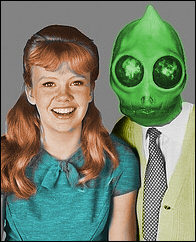Most of today's fans are familiar with the Phantom Stranger, the mysterious mystical observer and reluctant participatory protagonist of all things magic in the DCU.
But in his 1950's series he was much more mortal and less the supreme sorcerer than he is today. Back then he fought crime! The Phantom Stranger always seemed to show up just in time to foil some Ponzi scheme or other grift. The Stranger became involved whenever someone was about to be victimized by con-artists who used the trappings of the supernatural to take advantage of the stupid and gullible.
He was like a one-man Scooby-gang! While early issues did not have the Comics Code Authority seal on them (because the CCA didn't exist until 1954), it may be that DC saw the writings on the wall and conformed to public pressure and expectations. The editors may have ensured that while the Phantom Stranger stories could hint at the mystical, it was always revealed that the monster or mystic event was always mundane.
While early issues did not have the Comics Code Authority seal on them (because the CCA didn't exist until 1954), it may be that DC saw the writings on the wall and conformed to public pressure and expectations. The editors may have ensured that while the Phantom Stranger stories could hint at the mystical, it was always revealed that the monster or mystic event was always mundane.
The mystical was frowned upon in popular media in the 1950's (a parallel would be the Fundamentalist outcry against Harry Potter today) and it was discouraged to have it shown as real. Here are the rules for the how to depict the supernatural in Part B of the CCA:
General Standards Part B:
1) No comic magazine shall use the word "horror" or "terror" in its title.
2) All scenes of horror, excessive bloodshed, gory or gruesome crimes, depravity, lust, sadism, masochism shall not be permitted.
3) All lurid, unsavory, gruesome illustrations shall be eliminated.
4) Inclusion of stories dealing with evil shall be used or or shall be published only where the intent is to illustrate a moral issue and in no case shall evil be presented alluringly nor so as to injure the sensibilities of the reader.
5) Scenes dealing with, or instruments associated with walking dead, torture vampires and vampirism, ghouls, cannibalism, and werewolfism are prohibited.
While nothing specifically forbid the Stranger and other characters from being wholly magikal* it was better to be safe than sorry back in the 1950's. No sense in pushing your luck as a publisher.
However, many companies knew how to be subtle and fly under the radar, and in their many anthology comic books DC made it a specialty. In fact the creative teams played it so clever they always left themselves an "out" in the event someone complained about content. If DC received a complaint that they were promoting Satanic values, mysticism or whatever by having the Phantom Stranger mystically disappear at the end of a story they could reference the panels in question and easily dismiss any criticism.
Yes, the Phantom Stranger did mysteriously vanish on many occasions. But there was nothing supernatural about it at all.
 He disappeared by simply walking away when no one was paying attention.
He disappeared by simply walking away when no one was paying attention.Tags: DC Comics Phantom Stranger Seduction of the Innocent
*So? I'm feeling Claremontian tonight.



























The one with the exit sign is most hilarious.
ReplyDelete"What the hell? Where on earth? wha? Huh? How could he...??? Etc."
(Cut to Phantom Stranger, whistling as he strolls out the EXIT door)
That one is great. And the fairground panel is cool too. That's probably him in the hat walking away.
ReplyDelete